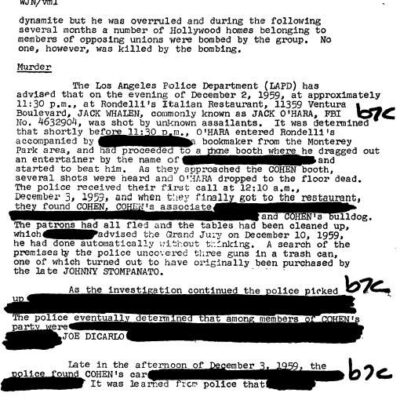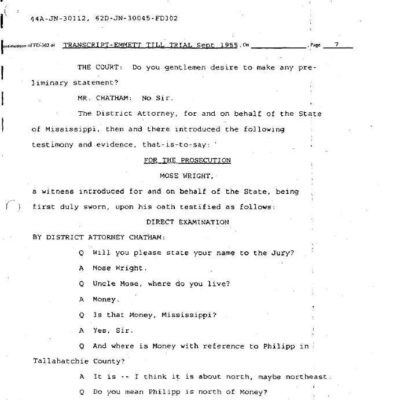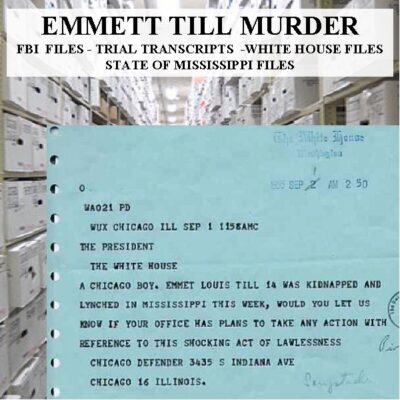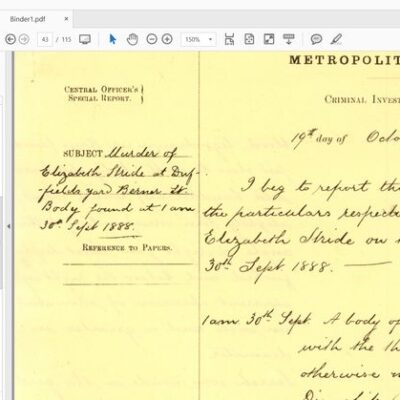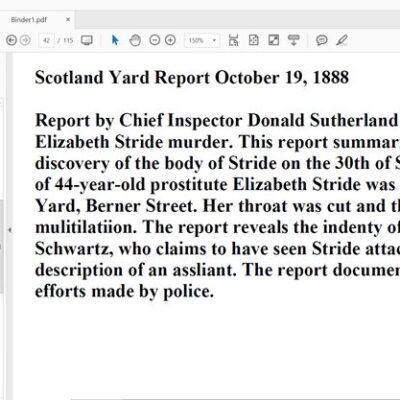
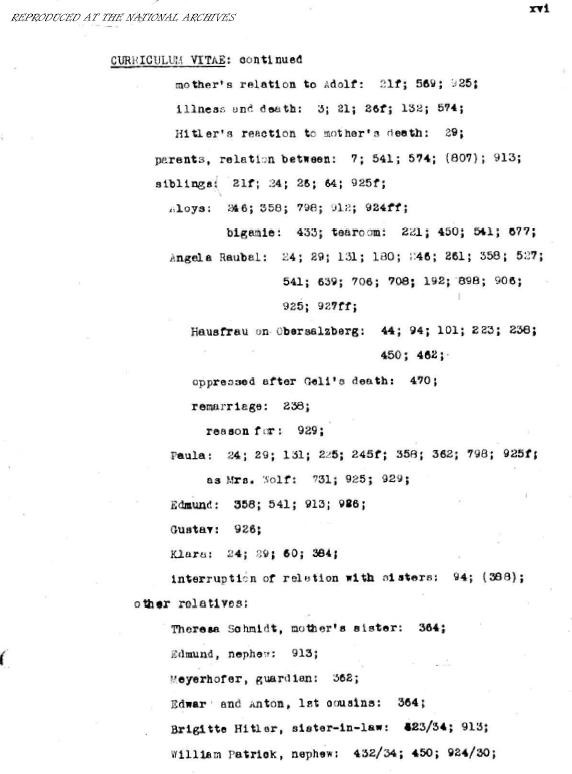
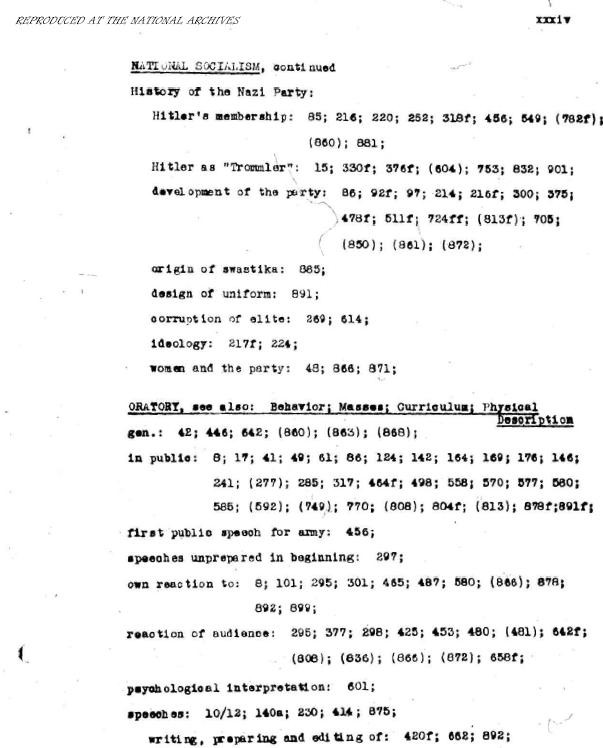
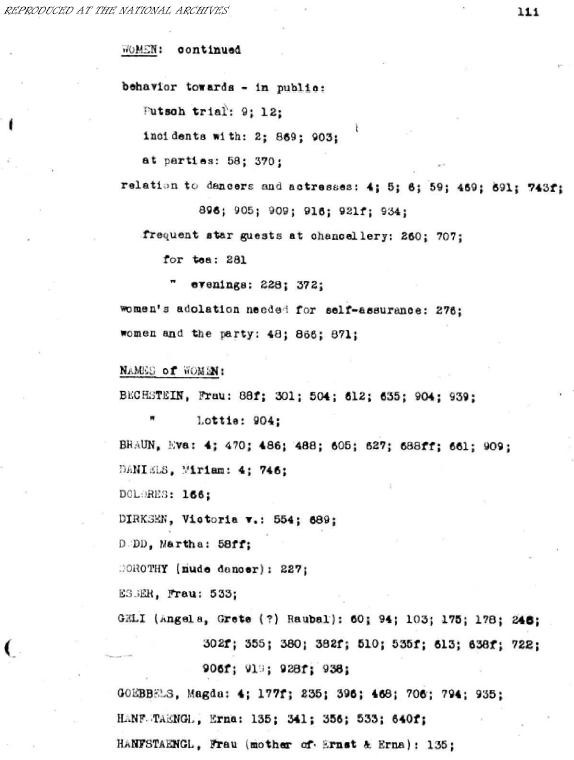
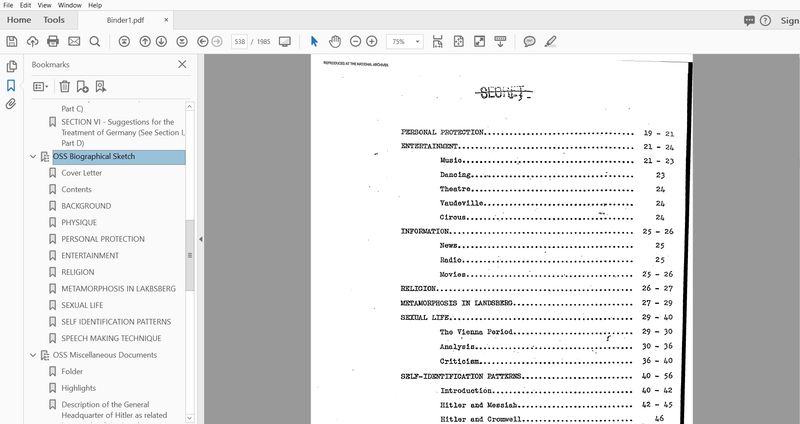
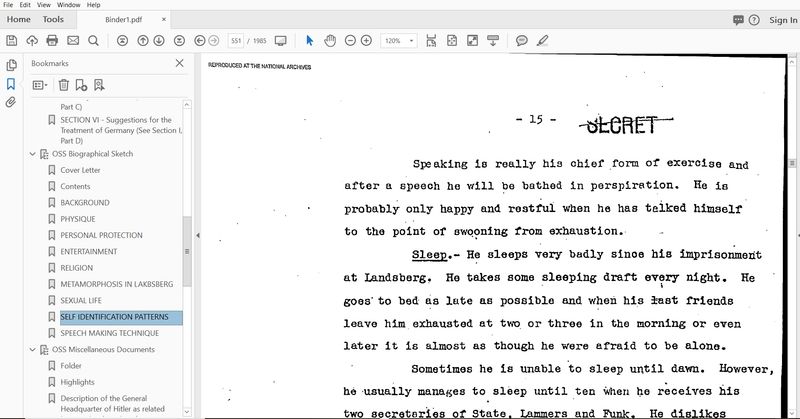
Adolf Hitler: OSS – CIA Files
$19.50
Description
The collection contains 1,860 pages of documents from the Office of Strategic Services (OSS) pertaining to Adolf Hitler. These documents include a biographical overview of Hitler, two analyses examining his psychological profile, an assortment of summaries sourced from materials related to him, as well as medical and physical health information about Hitler, in addition to various OSS files related to him.
Prior to the onset of World War II, the United States managed its foreign intelligence activities through the War Department. The armed forces collected information that was processed by the Office of the Coordinator of Information within the Department of State, which was established in July 1941. On June 13, 1942, President Franklin D. Roosevelt officially created the Office of Strategic Services. This agency was a civilian organization assigned to collect intelligence and conduct covert operations. The OSS was tasked with the responsibility of gathering, assessing, and interpreting intelligence to support efforts against the Axis Powers, as well as planning and executing operations aimed at obtaining intelligence.
The office operated under the authority of the Joint Chiefs of Staff and was led by William A. “Wild Bill” Donovan. Donovan, a former U.S. Army officer who won the Medal of Honor for his bravery in World War I, was also a classmate of President Roosevelt at Columbia University. The Office of Strategic Services (OSS), established specifically for World War II operations, was dissolved shortly after the war ended. On October 1, 1945, President Harry S. Truman officially terminated the OSS through an executive order. The agency ceased to exist completely on January 12, 1946, when Donovan resigned from his position. Although President Truman disbanded the OSS, he recognized that the United States required a “comprehensive and coordinated foreign intelligence program.” Consequently, he devised his own strategy for such a program, leading to the establishment of the Central Intelligence Agency (CIA) as outlined in the National Security Act, which Congress passed on July 26, 1947. Many of the approximately 13,000 former OSS employees were incorporated into the newly created CIA.
In terms of biographical information, much of the content in this extensive 71-page report is derived from “Dr. Sedwick.” This name served as the OSS codename for Ernst Franz Sedwick Hanfstangl, who was not only an author but also a close associate of Adolf Hitler, holding the position of Nazi Press Chief during Hitler’s regime.
Hanfstangl escaped Germany in 1937 and sought refuge in England, where he was subsequently detained by British authorities as a German alien enemy. Eventually, he was transferred to a confinement camp for Germans located in Canada.
In 1942, he was released from that camp on parole to be of service to President Roosevelt. He was then put under the supervision of J. Franklin Carter, an assistant to the President. Hanfstangl’s role involved sharing his insights and understanding of Nazi Germany with the Office of Strategic Services and various other governmental entities.
The 1943 report highlights various subjects related to Adolf Hitler, including his familial history, educational background, publications, reading habits, mental concentration, reaction to auditory stimuli, ability to maintain silence, engage in conversation, and participate in debates. It also discusses his physical attributes, overall appearance, personal hygiene, stamina, exercise routines, vision, vocal qualities, sleep patterns, response to stimuli, dietary choices, drinking behaviors, smoking tendencies, self-defense practices, and preferred forms of entertainment, such as music, dance, theater, film, vaudeville, and circus performances. Additionally, it examines how he gathered information through news and radio sources, as well as the transformation he underwent during his time in Landsberg prison. The report further delves into aspects of his sexual life and his public speaking techniques, which encompass preparation for speeches, his entrance onto the stage, handling interruptions, maintaining posture, oratory skills, structuring conclusions, avoiding the mention of specific names and figures, and his exit strategies post-speech.
This comprehensive analysis is captured in a confidential wartime document comprising 281 pages, written by psychologist Walter C. Langer in 1943. Under the direction of General William J. Donovan, who led the Office of Strategic Services, there was a recognized need to create a psychological profile of Adolf Hitler. The intent behind this initiative was to gain a better understanding of both Hitler himself and the broader German populace, with the potential to inform Allied propaganda efforts and strategies for future interactions with Hitler and Germany. To produce this in-depth report titled “A Psychological Analysis of Adolph Hitler: His Life and Legend,” Langer collaborated with notable experts, including Professor Henry A.
Murray from Harvard Psychological Clinic, Dr. Ernst Kris from the New School for Social Research, and Dr. Bertram D. Lewin from the New York Psychoanalytic Institute. This report begins with a clear assertion: “This study is not propagandistic in any sense of the term.” The purpose of this research is to sift through the vast array of conflicting, contradictory, and unreliable information concerning Hitler, organizing it into categories that can assist policy-makers and those involved in counter-propaganda efforts. To achieve this, the initial three sections provide a comprehensive overview of Hitler from various perspectives: (1) how he perceives himself, (2) how he has been portrayed to the German populace, and (3) how he is perceived by those close to him. These foundational sections lay the groundwork for the psychological exploration found in sections IV and V, where an endeavor is made to comprehend Hitler as an individual and the driving forces behind his actions.
The researchers faced significant challenges due to their inability to engage directly with Hitler. The materials available for such an investigation were sparse and inconsistent at best. However, they did have access to an extensive collection of published works about Hitler, as well as testimonials from several individuals who had personal knowledge of him. Langer notes that the feasibility of this study relied heavily on the notable consensus among different informants regarding Hitler’s behaviors, feelings, and outlooks. To address the gaps left by insufficient direct data, the researchers drew upon their clinical experience working with similar personality types.
The report is structured around key themes: Adolf Hitler’s self-perception; the image of Adolf Hitler held by the German people; the perspective of Adolf Hitler as seen by his associates; an analysis of Adolf Hitler’s self-awareness; psychological analysis and reconstruction; and predictions regarding Adolf Hitler’s likely future conduct. Analysis of Adolf Hitler’s Personality: Predictions for His Future Behavior and Recommendations for Handling Him Post-Germany’s Surrender
In October 1943, Dr. Henry A. Murray, a psychologist from Harvard University, completed an extensive 240-page report. This document aimed to provide an in-depth analysis of Adolf Hitler’s personality traits and the factors that contributed to their development over time. The insights gained from this analysis were intended to forecast Hitler’s potential actions following an Allied victory and to formulate strategies on how he should be treated if captured. The report was designed to assist the Office of Strategic Services (OSS) in understanding how they might be able to influence Hitler’s mental state and conduct. Dr. Murray accurately anticipated that Hitler would likely choose suicide as his final course of action. He posited that a comprehensive understanding of Hitler’s psyche would also illuminate the psychological landscape of the German populace.
In compiling his analysis, Murray utilized a variety of data sources provided by the OSS, including Hitler’s educational records, military documentation, publicly available news articles, and German cinema. Notable texts that informed his research included Hitler’s own writings such as “Mein Kampf” and “My New Order,” along with biographies and critical analyses like Konrad Heiden’s “Hitler, A Biography,” Herman Rauschning’s “Voice of Destruction,” and Helton G. Baynes’ “Germany Possessed.”
The report is divided into several key sections, which include: an overview titled “Hitler the Man: Note for a Case History,” an intricate examination of Hitler’s psychological profile specifically tailored for professionals in psychology and psychiatry, predictions regarding Hitler’s future actions, as well as guidelines for managing him during and after Germany’s capitulation, and recommendations for addressing the broader issues within Germany. The section “Hitler the Man: Note for a Case History” was authored by W.H.D. Vernoin under Dr. Murray’s guidance and encapsulated the prevailing knowledge about Hitler at the time when the research for the report commenced.
Hitler Source Book A comprehensive document spanning 1,019 pages was created by Walter C. Langer for the Office of Strategic Services (OSS). Out of this extensive material, around 700 pages are clearly legible and contain valuable insights. This document features summaries extracted from various sources that Langer utilized while compiling his analysis titled “A Psychological Analysis of Adolph Hitler: His Life and Legend.” The report comprises essential excerpts from a total of 211 distinct references.
The content includes:
- An account from a physician who provided treatment to Adolf Hitler.
- Cables sent by British diplomats who were in contact with Hitler just before the German invasion of Poland.
- Selected portions from the diary of Ambassador William Dodd, who served as the head of the U.S. Embassy in Berlin between 1933 and 1937.
- A report featuring intelligence gathered from a high-ranking German officer who discussed Hitler’s demeanor during interactions with the German military leadership.
- Portions of the “Berlin Diaries,” a supposed journal kept by an unnamed official from the Berlin War Office, documenting daily insights into political maneuvering and intrigues within the German War Ministry, as well as Hitler’s rise to power during the years 1932 to 1933.
- Excerpts from William Shirer’s Berlin Diary. Shirer was known for authoring “The Rise and Fall of the Third Reich” and worked as a CBS radio correspondent under Edward R. Murrow’s direction, maintaining a diary while in Berlin from 1937 until December 1940.
- An interview conducted by the OSS with a former chief of police in Berlin.
- Dispatches from the Department of State detailing Hitler’s actions and movements.
- An OSS interview with Princess Stephanie Marie Von Hohenlohe, who was detained in a Texas camp at the time. She was known as a close associate of Hitler, Goering, and Ribbentrop, and even received accolades from Hitler for her espionage efforts.
- An OSS interview with Ferdinand Jahn, a reporter for United Press who was active in Germany during the 1920s and who had met with Hitler two days prior to the failed coup known as the Beer Hall Putsch in November 1923. Information gathered from Ernst Franz Sedwick Hanfstangl comes from an interview conducted by the Office of Strategic Services (OSS) with William Patrick Hitler, who is Adolf Hitler’s nephew.
Miscellaneous Office of Strategic Services Files
This collection consists of 110 pages containing documents from both the OSS and the CIA that pertain to Adolf Hitler. The files range in date from 1941 to 1955 and include evaluations of Hitler’s speeches as well as plans for creating disinformation campaigns within Germany, aimed at undermining Hitler’s image and reputation.
Surgeon General’s Intelligence Unit Report
A comprehensive 43-page document titled “Studies in Pathography II. Adolph Hitler” was produced after World War II by Morris C. Leikind. He was a medical historian and archivist who focused on medical intelligence work within the Surgeon General’s office during the war.
In the report’s introduction, Leikind stated, “It is quite challenging to elucidate Hitler’s remarkable life solely through the lens of his medical history. This analysis will categorize Hitler’s medical background into two main areas: (a) psychiatric factors and (b) somatic or physical conditions. Given the extensive literature already published about Hitler’s mental health and considering the contentious and speculative nature surrounding the existing information, this report will limit its discussion on Hitler’s psychological state.”
U.S. Military Intelligence Reports – Interrogations of Hitler’s Doctors
The series of reports entitled “Hitler as Seen by His Doctors,” spans a total of 96 pages and began on October 15, 1945. These documents are based on testimonies collected from medical professionals who examined and treated Hitler in the year preceding the reports. At that time, military intelligence indicated that the goal of gathering this information was to compile medical evidence that could assist in identifying Adolf Hitler or any potential remains attributed to him. Additionally, this data would serve as further evidence to dismantle various “Hitler Myths” that had proliferated over the years. It was also aimed at acquiring insights necessary to challenge any impostors who might later claim to be Hitler or assert they had interacted with him. Moreover, it would contribute valuable research materials for historians, medical professionals, and scientists interested in studying Hitler.
The doctors who were questioned included Dr. Theo Morel, Dr. Erwin Giesing, Dr. Hanskarl Hasselback, Dr. Karl Brandt, Dr. Walter Loehlein, Dr. Karl Weber, Dr. A. Nissel, and Dr. A. Brinkmann. The report notes that each physician was interviewed individually, and there was no effort made to analyze their findings collectively.
Each doctor’s interview covered a range of topics, including:
- Overall Medical Background
- Scarring
- Skin Conditions
- Facial Features
- Head Health
- Neck Condition
- Chest Examination
- Lung Function
- Heart Health
- Abdominal Assessment
- Lymphatic System
- Back Issues
- Rectal and Genital Inspection
- Limb Conditions
- Neurological Assessments
- Psychiatric Evaluations
- Urological Health
- Sexual History
- Radiographic Studies
- Stool Tests
- Blood Testing
- Electrocardiograms
The appendices of this report feature:
- A timeline detailing the life and career of Prof. Dr. Theo Morell
- Five X-rays depicting Hitler’s skull
- Documentation regarding the X-ray examinations
- Findings from an ear examination
- Illustrations of Hitler’s mouth
- Records pertaining to heart evaluations
- Four electrocardiogram results
- Outcomes from two urinalyses
- Results from three stool tests
- An illustration of Hitler’s nose
- Blood sedimentation rate assessments
- Blood calcium level evaluations
- Vassermann, Mucin-like, and Kahn test outcomes
- Differential blood count results
- Blood serum differentiation findings
- Translations of consultation notes made by Morell
The third document in this series focuses specifically on Hitler’s dental health. It draws from details provided by Dr. Hugo Johannes Blaschke, who served as Hitler’s dentist from 1934 until February 1945. This section also includes observations about the dental health of Martin Bormann and Eva Braun.
X-rays of Hitler’s skull were conducted following complaints he made about headaches and vision issues after the assassination attempt on his life on July 20, 1944. These x-rays, along with his dental records, played a crucial role in helping French researchers confirm the authenticity of Hitler’s remains in 2018. The collection consists of two copies of the reports titled “Hitler as Seen by his Doctors.” One copy is sourced from the National Archives and Records Administration, while the other originates from the British National Archives. It is not uncommon for certain documents to be present in one archive but absent in the other. Additionally, the clarity of text on identical pages may vary between the two collections. Typically, the documents housed in the British National Archives exhibit better legibility.
https://www.npr.org/sections/thetwo-way/2018/05/21/612932451/french-researchers-hitler-really-did-die-in-the-bunker-in-1945
Included within these files is a textual transcript that captures all recognizable text found within the graphic images
Adolf Hitler OSS – CIA Files
Overview: This briefing document reviews the main themes and significant findings from a collection of declassified OSS and CIA files related to Adolf Hitler. These files, totaling over 1,860 pages, offer a multifaceted perspective on Hitler’s life, personality, psychology, and physical health, as understood by US intelligence during and after World War II.
Key Sources:
- Biographical Sketch (1943): A 71-page report based primarily on information provided by Ernst Franz Sedwick Hanfstangl (“Dr. Sedwick”), a former close associate of Hitler. This report covers a wide range of topics, including Hitler’s family background, education, personal habits, and speaking techniques.
- Psychological Analyses:
- “A Psychological Analysis of Adolph Hitler: His Life and Legend” (1943): A 281-page report authored by Walter C. Langer for the OSS. This report attempts to understand Hitler’s motivations and behavior based on available biographical information and insights from informants who knew him.
- “Analysis of the Personality of Adolph Hitler: With Predictions of His Future Behavior and Suggestions for Dealing with Him Now and After Germany’s Surrender” (1943): A 240-page report by Harvard psychologist Dr. Henry A. Murray. This report provides a detailed psychological profile of Hitler and predicts his future actions, including the chillingly accurate prediction of his suicide.
- “Hitler Source Book”: A 1,019-page document compiled by Walter C. Langer containing abstracts and key points from over 200 sources used in his psychological analysis. This source book offers a wealth of primary material, including interviews with individuals who interacted with Hitler and excerpts from contemporary accounts.
- Medical and Intelligence Reports:
- “Studies in Pathography II. Adolph Hitler” (Post-War): A 43-page report by Morris C. Leikind focusing on Hitler’s medical history, with particular emphasis on his physical ailments.
- “Hitler as Seen by his Doctors” (1945): A series of reports based on interrogations of Hitler’s doctors, totaling 96 pages. These reports provide detailed information about Hitler’s physical and mental health during the final year of the war.
Main Themes and Important Findings:
- Psychological Profile: The psychological analyses paint a complex and disturbing picture of Hitler’s personality. They highlight his:
- Narcissism and Messiah Complex: The reports describe Hitler’s belief in his own greatness and his conviction that he was destined to lead Germany to world domination.
- Paranoid Tendencies and Deep-Seated Hatreds: Hitler is shown to be deeply suspicious and distrustful of others, harboring intense hatreds, particularly towards Jews.
- Psychopathic Traits: The analyses identify traits consistent with psychopathy, including a lack of empathy, remorse, and a willingness to exploit others.
- Propaganda and Image Construction: The files demonstrate the careful and deliberate construction of Hitler’s public image. His speeches were carefully crafted to appeal to the emotions and prejudices of the German people. The Nazi propaganda machine worked tirelessly to portray him as a charismatic and infallible leader.
- Physical Health: The medical reports and interrogations of Hitler’s doctors reveal a man in declining physical health, suffering from various ailments, including tremors, digestive problems, and potential neurological issues. The reports document his extensive use of medications, some of which could have contributed to his erratic behavior.
- Debunking Myths: The “Hitler as Seen by his Doctors” reports aimed to debunk myths and rumors surrounding Hitler, particularly those related to his supposed survival. They sought to provide a factual and objective account of his medical condition and ultimate demise.
Important Quotes:
- From “A Psychological Analysis of Adolph Hitler”: “This study is not propagandistic in any sense of the term. It represents an attempt to screen the wealth of contradictory, conflicting and unreliable material concerning Hitler into strata which will be helpful to the policy-makers and those who wish to frame counter-propaganda.”
- From “Analysis of the Personality of Adolph Hitler”: “Predictions of Hitler’s Behavior in the Coming Future” – This section highlights Murray’s chillingly accurate prediction that Hitler’s most likely end would be suicide.
- From “Hitler Source Book”: This vast collection of source materials provides countless insights into Hitler’s personality and actions, offering a diverse range of perspectives from those who knew him or observed him closely.
Significance: These OSS and CIA files provide invaluable historical documentation. They offer a window into the intelligence efforts of the United States during and after World War II, revealing the attempts to understand and predict the actions of one of history’s most notorious figures. The psychological analyses offer insights into the mind of a dictator and the factors that contributed to the rise of Nazi Germany.
Further Research:
- Analyze the methodologies used in the psychological profiles and their limitations, given the lack of direct access to Hitler.
- Compare the findings of these reports with contemporary and subsequent historical analyses of Hitler’s personality and motivations.
- Explore the use of these intelligence reports in shaping Allied policy during and after the war.
